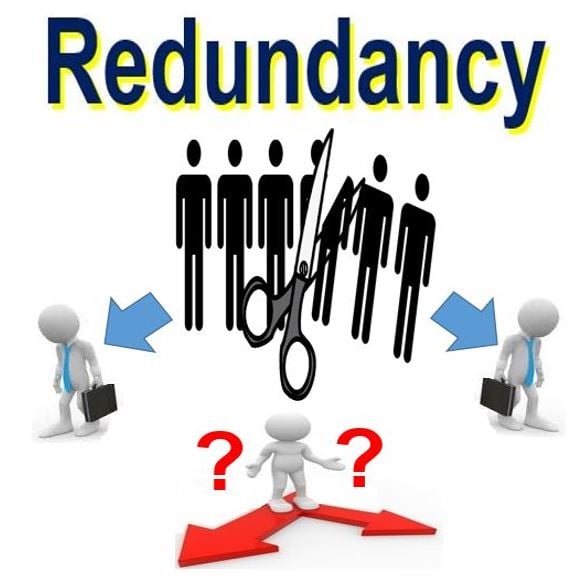Small Business Closing Employee Rights UK: Ensuring Fair Redundancy Pay
Small Business Closing Employee Rights UK: Ensuring Fair Redundancy Pay
Blog Article
Checking Out the Interplay Between Business Redundancy and Business Flexibility for Future Growth
In the dynamic landscape of today's organization world, the elaborate partnership in between company redundancy and organizational flexibility emerges as a critical factor for sustained growth and success. Firms often encounter the obstacle of striking a fragile balance between maintaining a degree of redundancy to alleviate threats and cultivating versatility to respond promptly to the ever-evolving market needs.
Significance of Business Redundancy
Firm redundancy is a vital component that improves organizational strength and reduces functional threats. By including redundancy measures within the business structure, companies can better hold up against unpredicted disturbances and variations in business atmosphere. Redundancy acts as a calculated buffer, permitting business to adapt and respond properly to unforeseen difficulties without jeopardizing crucial operations.
One key element of the importance of business redundancy is its function in making certain continuity throughout times of situation. When encountered with abrupt modifications or emergencies, redundant systems, sources, or workers can step in to preserve essential functions and stop extensive disruptions. This continuity not just safeguards the firm's reputation and consumer trust fund yet also reduces economic losses and operational downtime.

Techniques for Business Adaptability

Creating versatile organizational structures that permit for fast adjustments to market characteristics and client demands is necessary for staying affordable in a swiftly evolving atmosphere. By proactively identifying potential disruptions and opportunities, companies can proactively prosper and adjust in an ever-changing service landscape.
Balancing Redundancy and Versatility
Achieving an unified stability between operational redundancy and organizational versatility is paramount in navigating the complexities of a vibrant company atmosphere. Redundancy within a company gives a safeguard, making certain continuity and stability in operations. Nevertheless, an excess of redundancy can cause inefficiencies and hinder flexibility to transforming market conditions. On the other hand, organizational flexibility allows firms to react immediately to external interruptions and take brand-new chances. Striking the best balance between redundancy and adaptability redundancy if company goes bust is a fragile process that requires a deep understanding of the organization's objectives, sector dynamics, and danger resistance.
To achieve this balance, firms require to perform regular analyses of their operations to identify areas where redundancy is required for danger mitigation and where versatility can drive innovation and development. Applying adaptable structures, cultivating a culture of constant knowing and enhancement, and encouraging open communication throughout all degrees of the organization are essential strategies to balance redundancy and adaptability efficiently. By lining up these two critical elements, companies can position themselves for sustainable development and success in an ever-changing organization landscape.
Case Research Studies on Adjustment Success
In taking a look at instances of effective organizational adaptation, it ends up being obvious that the interaction between functional redundancy and adaptability is a specifying consider shaping resistant businesses. One engaging situation study is look at these guys that of Netflix. Originally a DVD rental service, Netflix showed exceptional versatility by transitioning into a streaming platform when digitalization disrupted the market. By tactically purchasing technology and material production, Netflix not only made it through but thrived in a rapidly evolving market. One more standout example is Amazon. Starting as an online book shop, Amazon constantly adjusted its organization design, increasing into diverse industries such as cloud computer and man-made intelligence. This versatility permitted Amazon to remain in advance of competitors and meet changing consumer demands. Lastly, Adobe supplies a notable image of effective adjustment. The business changed from marketing software licenses to a subscription-based version, making certain persisting revenue streams and enhanced customer engagement. These instance studies emphasize the value of functional redundancy combined with organizational flexibility in cultivating lasting development and competition.
Building Resilience for Future Development
Building strength for future growth needs a calculated alignment of operational procedures with market dynamics and emerging fads. Business should adapt to changing atmospheres by cultivating a society of adaptability, advancement, and continual improvement.
In addition, fostering strong relationships with stakeholders, such as consumers, employees, suppliers, and the area, is vital for weathering uncertainties and maintaining count on and assistance throughout unstable times. Efficient interaction and openness play a vital function in building resilience, as they assist facilitate and straighten assumptions cooperation in navigating uncertainties.
In addition, organizations need to focus on understanding and development efforts to upskill employees and furnish them with the essential devices to adjust to altering scenarios. By purchasing their workforce, business can improve their versatility and agility, ultimately strengthening their strength for sustainable future growth.
Conclusion

In the dynamic landscape of today's company globe, the detailed partnership between firm redundancy and organizational versatility emerges as More about the author an essential variable for continual development and success. Companies typically face the challenge of striking a fragile balance between keeping a degree of redundancy to reduce dangers and fostering adaptability to react quickly to the ever-evolving market needs.To accomplish this equilibrium, companies need to perform routine assessments of their procedures to recognize areas where redundancy is needed for threat reduction and where versatility can drive advancement and development.In conclusion, the interplay between firm redundancy and organizational versatility is essential for future growth. Structure strength with a mix of redundancy and versatility will certainly make certain that companies are prepared for the obstacles of the future.
Report this page